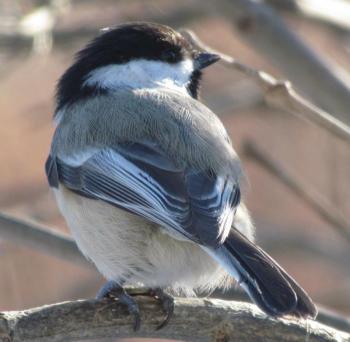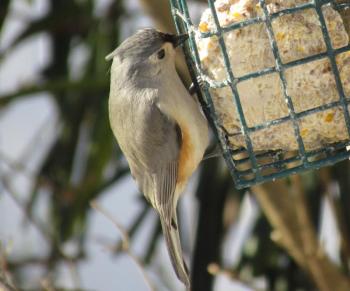Should You Listen to the Birds?
Each morning for the last week or so, our neighborhood has seemed to echo in bird song. The cheerful “PEA-ter, PEA-ter, PEA-ter” of a resident tufted titmouse has been serenading us on our dog walks. Sometimes a song sparrow joins the chorus, and black-capped chickadees “fee-bee” here and there. House finches, never shy to join a party, have been letting loose with their frolicking songs, and a cardinal adds his loud “cheer-cheer” to the soundscape now and then. We’ve even heard a yellow-bellied sapsucker give its “meew” call.
As we write, there’s still plenty of February—it’s late February. So why are these birds singing now?
There’s no doubt that they are gearing up for spring, just like we humans. In fact, the same changes that people notice this time of year also trigger a response in birds. If you’re like us, you’re grateful for every minute of increasing daylight. We love cold, snowy days (this is Maine, after all). But we’ll take those few gloriously warm ones among the frigid temps. This gradual increase in sunlight and increased temps (even though temporary) can also increase hormone levels in birds, stimulating them to begin singing more regularly.
This explains why they seldom sing this time of year for long periods of time. The primary reasons birds sing are to attract a mate and to establish and defend breeding territories. They can’t afford to put too much energy and time into that too early in the season, especially on really cold days when they need to just find food and stay warm so they can survive another night. Singing might occur a bit more often on warm late-winter days precisely because birds’ energy requirements are lower, allowing them to expend a little energy in singing energetically.
These cold winter days, let the songs of birds, however sporadic, inspire you. They can lift the spirit and ease a worried mind, even when the driveway is coated in ice and more snow is in the forecast. Maybe their voices will prompt you to log onto nrcm.org and audubon.org to see what you can do to help protect birds and their habitat. Contacting your lawmaker about a particular piece of legislation, implementing tips to cut down on waste, creating a bird-friendly yard using native plantings and shrinking the size of your lawn—these are a few steps among many that all of us can take to make a difference for birds and the environment.
By the way, if you find the whole birds-singing-in-winter thing confusing, don’t feel bad. The sapsucker we mentioned above…should be in the southern U.S. right now!
Jeffrey V. Wells, Ph.D., is a Fellow of the Cornell Lab of Ornithology and Vice President of Boreal Conservation for National Audubon. Dr. Wells is one of the nation's leading bird experts and conservation biologists and author of the “Birder’s Conservation Handbook.” His grandfather, the late John Chase, was a columnist for the Boothbay Register for many years. Allison Childs Wells, formerly of the Cornell Lab of Ornithology, is a senior director at the Natural Resources Council of Maine, a nonprofit membership organization working statewide to protect the nature of Maine. Both are widely published natural history writers and are the authors of the popular books, “Maine’s Favorite Birds” (Tilbury House) and “Birds of Aruba, Bonaire, and Curaçao: A Site and Field Guide,” (Cornell University Press).


























